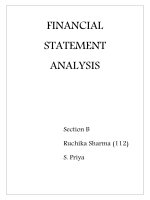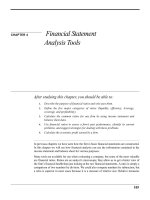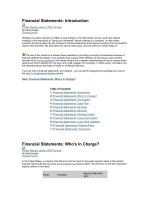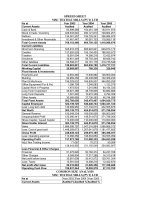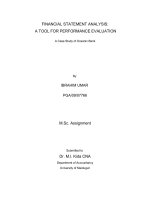Accounting & Financial Statement Analysis
Bạn đang xem bản rút gọn của tài liệu. Xem và tải ngay bản đầy đủ của tài liệu tại đây (20.62 MB, 291 trang )
CRASH COURSE IN
ACCOUNTING
AND FINANCIAL
STATEMENT ANALYSIS,
SECOND EDITION
MATAN FELDMAN
ARKADY LIBMAN
00_047011 ffirs.qxp 1/18/07 8:52 AM Page i
05_047011 ch02.qxp 1/16/07 6:59 PM Page 28
CRASH COURSE IN
ACCOUNTING
AND FINANCIAL
STATEMENT ANALYSIS,
SECOND EDITION
MATAN FELDMAN
ARKADY LIBMAN
00_047011 ffirs.qxp 1/18/07 8:52 AM Page i
This book is printed on acid-free paper. ∞
Copyright © 2007 by Wall Street Prep. All rights reserved.
Published by John Wiley & Sons, Inc., Hoboken, New Jersey.
Published simultaneously in Canada.
No part of this publication may be reproduced, stored in a retrieval system, or transmitted in any form or by any
means, electronic, mechanical, photocopying, recording, scanning, or otherwise, except as permitted under
Section 107 or 108 of the 1976 United States Copyright Act, without either the prior written permission of the
Publisher, or authorization through payment of the appropriate per-copy fee to the Copyright Clearance Center,
Inc., 222 Rosewood Drive, Danvers, MA 01923, 978-750-8400, fax 978-646-8600, or on the web at www.copy-
right.com. Requests to the Publisher for permission should be addressed to the Permissions Department, John
Wiley & Sons, Inc., 111 River Street, Hoboken, NJ 07030, 201-748-6011, fax 201-748-6008, or online at
/>Limit of Liability/Disclaimer of Warranty: While the publisher and author have used their best efforts in preparing
this book, they make no representations or warranties with respect to the accuracy or completeness of the con-
tents of this book and specifically disclaim any implied warranties of merchantability or fitness for a particular
purpose. No warranty may be created or extended by sales representatives or written sales materials. The advice
and strategies contained herein may not be suitable for your situation. You should consult with a professional
where appropriate. Neither the publisher nor author shall be liable for any loss of profit or any other commercial
damages, including but not limited to special, incidental, consequential, or other damages.
For general information on our other products and services, or technical support, please contact our Customer
Care Department within the United States at 800-762-2974, outside the United States at 317-572-3993 or fax
317-572-4002.
Wiley also publishes its books in a variety of electronic formats. Some content that appears in print may not be
available in electronic books.
For more information about Wiley products, visit our Web site at .
Library of Congress Cataloging-in-Publication Data:
Feldman, Matan, 1978-
Crash course in accounting and financial statement analysis / Matan Feldman, Arkady Libman. — 2nd ed.
p. cm.
Includes bibliographical references.
ISBN-13: 978-0-470-04701-9 (pbk.)
ISBN-10: 0-470-04701-1 (pbk.)
1. Accounting. 2. Financial statements. I. Libman, Arkady, 1978- II. Title.
HF5636.F45 2007
657—dc22
2006015443
Printed in the United States of America
10987654321
00_047011 ffirs.qxp 1/18/07 8:52 AM Page ii
iii
Contents
About the Authors viii
Preface x
Chapter 1 Introduction to Accounting 1
What Is Accounting? 1
Why Is Accounting Important? 2
Making Corporate Decisions 2
Making Investment Decisions 2
Accounting Facilitates Corporate and Investment Decisions 2
Who Uses Accounting? 2
U.S. Accounting Regulations 2
Generally Accepted Accounting Principles 2
Overview of the Securities and Exchange Commission 3
Overview of the Financial Accounting Standards Board 4
International Accounting Regulations 4
Convergence of U.S. GAAP and IFRS 6
Summary 6
Chapter 2 Basic Accounting Principles 11
Assumptions 11
Assumption 1: Accounting Entity 12
Assumption 2: Going Concern 13
Assumption 3: Measurement and Units of Measure 13
Assumption 4: Periodicity 14
Wrap-up: Assumptions 15
Principles 18
Principle 1: Historical Cost 18
Principles 2 and 3: Accrual Basis 18
Principle 4: Full Disclosure 21
Wrap-up: Principles 21
Constraints 24
Constraint 1: Estimates and Judgments 24
Constraint 2: Materiality 24
Constraint 3: Consistency 24
Constraint 4: Conservatism 24
Summary 27
01_047011 ftoc.qxp 1/18/07 8:53 AM Page iii
Chapter 3 Financial Reporting 29
Financial Reporting Overview 29
Finding Financial Reports 30
Form 10-K (Annual Filing) 30
Why Is the 10-K Important? 30
Form 10-Q (Quarterly Filing) 30
Other Important Filings 31
Form 8-K 31
Form S-1 31
Form 14A 31
Form 20-F 31
Summary 32
Chapter 4 Reading the Annual Report 35
Introduction 35
Letter to Stockholders 36
Financial Highlights 38
Management’s Discussion and Analysis 38
Financial Statements 40
Income Statement 40
Balance Sheet 41
Cash Flow Statement 41
Notes to Consolidated Statements 41
Report of Management’s Responsibilities 43
Certification of Financial Statements 46
Risk Factors 48
Legal Proceedings 48
Report of Independent Auditors 49
Directors and Officers 52
Summary 54
Chapter 5 Income Statement 55
What is the Income Statement? 55
Why Is It Important? 57
Revenues 57
Not All Income Is Revenue 58
Bad Debt Expense 61
What Is Bad Debt Expense? 61
Revenue Recognition: To Recognize and When? 61
Revenue Recognition: Long-Term Projects 62
Expense Recognition and Accrual Basis of Accounting 65
Basic Principles Revisited: Accrual Basis of Accounting
and Matching Principle 65
Putting It All Together: The Accrual Basis of Accounting 65
Why Use Accrual Accounting? 65
Accrual versus Cash Accounting: What’s the Difference? 66
Revenue Manipulation 67
Cost of Goods Sold 70
COGS Do Not Include Administrative Costs 70
Gross Profit 73
Selling, General and Administrative 75
Research and Development 77
Stock Options Expense 77
iv Contents
01_047011 ftoc.qxp 1/18/07 8:53 AM Page iv
Depreciation Expense 80
Depreciation Is a “Phantom” Noncash Expense 82
Straight-Line Depreciation Method 83
Accelerated Depreciation Methods 86
Depreciation Methods Compared 92
Amortization 92
Amortization Is a “Noncash” Expense (Like Depreciation) 93
What Is the Difference between Depreciation and Amortization? 93
Summary 96
Goodwill 96
Goodwill Not Amortized after 2001 96
Interest Expense 97
Interest Income 99
Other Nonoperating Income 99
Income Tax Expense 99
Equity Income in Affiliates 100
Minority Interest 102
Net Income 104
Shares Outstanding 104
Representation of Shares Outstanding in the Income Statement 104
Common Dividends 108
Preferred Dividends 108
Earnings per Share 108
Nonrecurring Items 110
Unusual or Infrequent Items 110
Discontinued Operations 112
Extraordinary Items 113
Accounting Changes 114
Earnings before Interest, Taxes, Depreciation, and Amortization 117
EBITDA: Popular Measure of a Company’s Financial Performance 118
EBITDA Has Several Shortcomings 119
EBIT 122
Summary 123
Chapter 6 Balance Sheet 129
Introduction 129
Assets Represent the Company’s Resources 131
Liabilities and Shareholders’ Equity Represent the Company’s Sources of Funds (i.e.,
How It Pays for Assets) 134
Lemonade Stand and the Accounting Equation 137
Balance Sheet 137
Double-Entry Accounting 138
Why Is Double-Entry Accounting Important? 143
Income Statement Revisited: Links to Balance Sheet 143
Retained Earnings: The Link Between Balance Sheet and Income Statement 144
Impact of Revenues on the Balance Sheet 145
Impact of COGS on the Balance Sheet 145
Impact of SG&A on the Balance Sheet 146
Impact of Depreciation on the Balance Sheet 146
Impact of Interest Expense on the Balance Sheet 146
Impact of Tax Expense on the Balance Sheet 146
Total Impact of the Year on the Balance Sheet 147
Summary 148
Contents v
01_047011 ftoc.qxp 1/18/07 8:53 AM Page v
Order of Liquidity 149
Current versus Noncurrent Assets 149
Current versus Long-Term Liabilities 149
Assets 153
Inventories 157
LIFO Reserve: The Link between FIFO and LIFO Inventory Methods 164
Writing Down Inventories 164
Deferred Taxes 164
PP&E, Net of Depreciation 169
Reconciliation of PP&E 170
Fixed Asset Impairments 175
Fixed Asset Retirement and Disposal 176
Intercompany Investments 177
Consolidation 179
Intangible Assets 179
Goodwill 181
Summary: Intangible Assets and Goodwill 184
Summary: Assets 186
Liabilities 190
Other Typical Current Liabilities 192
Debt 193
Short-Term Debt versus Long-Term Debt 193
Capital Leases 194
Operating Leases 194
Deferred Taxes 195
Summary: Deferred Taxes 197
Pensions 198
Defined Benefit Plan 202
Minority Interest 205
Summary: Liabilities 209
Shareholders’ Equity 212
Introduction 213
Common Stock 214
Additional Paid-In Capital 214
Preferred Stock 215
Treasury Stock 216
Retained Earnings 217
Summary: Shareholders’ Equity 219
Summary 222
Chapter 7 Cash Flow Statement 223
Introduction 223
Cash Flow Statement to the Rescue! 225
Cash Flow from Operations 228
Overview 228
Indirect Method 228
Getting from Net Income to Cost from Operations 229
Depreciation 231
Working Capital 233
Changes in Accounts Receivable 235
Changes in Accounts Receivable and the Lemonade Stand 235
Changes in Inventories 236
Changes in Inventories and the Lemonade Stand 237
Changes in Accounts Payable 239
Accounts Payable and the Lemonade Stand 239
Changes in Other Current Assets 240
vi Contents
01_047011 ftoc.qxp 1/18/07 8:53 AM Page vi
Changes in Other Current Liabilities 241
Increases/Decreases in Deferred Taxes 241
Summary: Cash Flow from Operations 244
Cash Flow from Investing Activities 247
Overview 247
Components 247
Cash Flow from Financing Activities 251
Overview 251
Components 251
How the Cash Flow Is Linked to the Balance Sheet 255
Summary 256
Online Exercise 256
Chapter 8 Financial Ratio Analysis 259
Introduction 259
What Is Financial Ratio Analysis? 259
Liquidity Ratios 260
Current Ratio 260
Quick (Acid) Test 260
Current Cash Debt Coverage Ratio 261
Profitability Ratios 261
Gross Profit Margin 261
Profit Margin on Sales 261
Return on Assets 262
Return on Equity 262
Earnings per Share 262
Price-to-Earnings Ratio 262
Payout Ratio 262
Activity Ratios 262
Receivables Turnover 263
Days Sales Outstanding 263
Inventory Turnover 263
Days Sales of Inventory 263
Asset Turnover 263
Coverage Ratios 263
Debt to Total Assets 264
Times Interest Earned 264
Cash Debt Coverage Ratio 264
Calculations 265
Appendix 267
Stock Options 267
Stock Options Expensing 268
Then . . . 268
. . . and Now 269
Debt 270
How Are These Two Forms of Capital Raised? 270
Who Issues Debt? 270
Long-Term Debt 271
Capital versus Operating Leases 272
Direct Method 272
Index 275
Contents vii
01_047011 ftoc.qxp 1/18/07 8:53 AM Page vii
Matan Feldman is Founder and CEO of Wall Street Prep, a provider of step-by-step
self-study courses and customized university and corporate training seminars in
financial accounting, corporate finance, financial modeling, valuation modeling, and
M&A modeling. Before Wall Street Prep, he has worked as an Equity Research
Associate at JPMorgan Chase & Co. and as a Financial Analyst in the M&A group at
Chase Manhattan Bank. He received an MA in Economics with Honors from Boston
University.
Arkady Libman is the Managing Director of Wall Street Prep. Before Wall Street
Prep, he has worked as an Equity Research Associate at Friedman Billings Ramsey &
Co. and as an Investment Banking Analyst at JPMorgan Chase & Co. Arkady com-
pleted coursework at the London School of Economics and graduated with Honors
from Bowdoin College with a BA in Economics.
Established by investment bankers,
Wall Street Prep is a global full-service
financial training firm, providing self-study programs as well as instructor-led train-
ing and e-learning services to investment banks, financial institutions, Fortune 1000
companies, and academic institutions.
Self-Study Programs Available Online (www.wallstreetprep.com)
Crash Course in Reading and Analyzing Financial Reports
➢ Learn to navigate through and make sense of the most ubiquitous financial
reports, such as the 10-K, 10-Q, 8-K, S-4, S-1, and many others.
➢ Learn to recognize patterns in the structure of the various financial reports to
improve efficiency on the job.
➢ Taught using clear, easy-to-follow materials that bridge academic concepts with real-
life applications and filled with exercises that test and reinforce covered concepts.
About the Authors
viii
02_047011 fbetw.qxp 1/18/07 8:53 AM Page viii
Crash Course in Finance
➢ Understand various methodologies used to analyze capital projects.
➢ Learn to derive the value of stocks and bonds.
➢ Understand the cost of debt, the cost of equity, and the weighted average cost of
capital.
Crash Course in Excel for Finance
➢ Learn Excel Basics—menu commands, data manipulation, and formatting.
➢ Gain Excel proficiency—calculations, functions, formulas, and Excel best practices.
➢ Understand advanced Excel features—data tables and macros.
Step-by-Step Financial Modeling
➢ Simulate on-the-job financial modeling using our tutorial materials and Excel
model templates.
➢ Build, understand, analyze, and interpret complex financial earnings models.
➢ Step-by-step instructions on building projections of financial statements.
Step-by-Step Advanced Valuation Modeling
➢ Learn Discounted Cash Flow (DCF) modeling, Leveraged Buyout (LBO) analy-
sis, M&A analysis, comparable company analysis (“Comps”), and comparable
transaction analysis.
➢ Step-by-step instruction on building, understanding, analyzing, and interpreting
applications of traditional valuation methodologies the way it is done in the
finance industry.
About the Authors ix
02_047011 fbetw.qxp 1/18/07 8:53 AM Page ix
Crash Course is not an accounting textbook. We believe that standard accounting
texts make the subject inaccessible for the nonaccountant. This is a crash course,
born out of years of our experience training students and professionals who need to
learn accounting quickly in order to understand financial reports, perform financial
analysis, and speak the language of business. Our trainees come from universities,
Fortune 500 companies, consulting firms, law firms, and financial institutions all
over the world. This crash course was written for both those with no prior account-
ing background, and for those who are a little rusty and need a refresher.
This book begins with an analysis of basic accounting rules and their impact on
real-world situations, and then analyzes the structure and composition of the key
financial filings (10-K, 10-Q, 8-K, etc.). Financial statements are then introduced, ana-
lyzed, and methodically deconstructed; the income statement, balance sheet, cash
flow statement, and their important interactions, are thoroughly analyzed and dis-
cussed line-by-line. Finally, we conclude with a discussion of ratio analysis, tying
together earlier concepts in the book.
Written in a clear, easy-to-follow style that makes accounting accessible, this
book is filled with exercises that test and reinforce covered concepts. Throughout
the book, extensive discussion focuses on a number of accounting case studies
(WorldCom and AOL) and on recent developments in accounting (from stock
options expensing to the convergence of U.S. and international accounting princi-
ples), with special emphasis placed on their real-world impact.
Good luck.
Matan Feldman
Arkady Libman
Preface
x
03_047011 fpref.qxp 1/18/07 8:54 AM Page x
1
CHAPTER
What Is Accounting?
Accounting is the language of business. It is a standard set of rules for measuring a
firm’s financial performance. Assessing a company’s financial performance is impor-
tant for many groups, including:
➢ The firm’s officers (managers and employees)
➢ Investors (current and potential shareholders)
➢ Lenders (banks)
➢ General public
Standard financial statements serve as a yardstick of communicating financial
performance to the general public.
For example, monthly sales volumes released by McDonald’s Corp. provide both
its managers and the general public with an opportunity to assess the company’s
financial performance across major geographic segments.
Introduction to
Accounting
1
04_047011 ch01.qxp 1/16/07 6:52 PM Page 1
Why Is Accounting Important?
Making Corporate Decisions
Suppose a telecom company is looking to acquire a regional company to boost its
presence in that region. There are several potential targets that fit the bill. How does
this company determine which of these targets, if any, would make a good acquisi-
tion candidate?
Making Investment Decisions
A mutual fund is looking to invest in several diverse technology companies—
Microsoft, Oracle, and Intel. How does this mutual fund determine in which of these
targets it should make an investment?
Accounting Facilitates Corporate and Investment Decisions
A major part of corporate and investment decisions relies on analyzing all of the
companies’ financial information in the above-mentioned cases. Accounting, the
standard language by which such financial information can be assessed and com-
pared, is fundamental to making these decisions.
Who Uses Accounting?
Accounting is used by a variety of organizations, from the federal government to
nonprofit organizations to small businesses to corporations (Exhibit 1.1). We will be
discussing accounting rules as they pertain to publicly traded companies.
U.S. Accounting Regulations
Accounting attempts to standardize financial information, and like any language,
follows rules and regulations. What are these accounting rules, how are they estab-
lished, and by whom?
Generally Accepted Accounting Principles
In the United States, a governmental agency called the Securities and Exchange
Commission (SEC) authorizes the Financial Accounting Standards Board (FASB) to
determine U.S. accounting rules.
FASB communicates these rules through the issuance of Statements of Financial
Accounting Standards (SFAS). These statements make up the body of U.S. accounting
2 Introduction to Accounting
04_047011 ch01.qxp 1/16/07 6:52 PM Page 2
rules known as the Generally Accepted Accounting Principles (GAAP). These rules
have been developed to provide guidelines for financial accounting in order to ensure
that businesses present their financial information on a fair, consistent, and straight-
forward basis. Financial statements of U.S. companies must be prepared according to
U.S. GAAP.
Overview of the Securities and Exchange
Commission
The SEC is a U.S. federal agency that was established by the U.S. Congress in 1934.
The agency’s primary mission is “to protect investors and maintain the integrity
of the securities markets,” which includes the establishment and maintenance of
accounting principles and regulations. The SEC comprises five presidentially
appointed commissioners heading approximately 3,100 staff employees across 4 divi-
sions and 18 offices (Exhibit 1.2).
Overview of the Securities and Exchange Commission 3
EXHIBIT 1.1 WHO USES ACCOUNTING?
The accounting umbrella
Governmental
Accounting
Nonprot
Organizations
Sole
Proprietorship
Partnership
Private
Corporation
Publicly Traded
Our focus
For-prot
Organizations
04_047011 ch01.qxp 1/16/07 6:52 PM Page 3
Overview of the Financial Accounting
Standards Board
The SEC has historically charged the private sector with establishing and maintain-
ing financial accounting and reporting standards. Accordingly, FASB was estab-
lished in 1973 to carry out these functions on the behalf of the SEC.
FASB is composed of seven full-time members appointed for five years by the
Financial Accounting Foundation (FAF), a parent organization. FASB formulates
accounting standards through the issuance of Statements of Financial Accounting
Standards (SFAS). These statements make up the body of accounting rules known as
the Generally Accepted Accounting Principles (GAAP). While FASB is independent,
with close relations with the SEC, its decisions are influenced by a variety of entities
(Exhibit 1.3).
International Accounting Regulations
Up to now, we have discussed accounting regulations and the bodies that oversee
them in the United States. But what about companies that must answer to the
accounting regulations of other countries?
Fortunately, there has been unprecedented convergence between the accounting
standards for the United States and other countries over the last 30 years. Here is a
brief recap of the history of this convergence.
In 1973, the International Accounting Standards Committee (IASC) was founded
by accountancy bodies in Australia, Canada, France, Germany, Ireland, Japan,
4 Introduction to Accounting
EXHIBIT 1.2 SEC ORGANIZATIONAL STRUCTURE
Securities & Exchange Commission (SEC)
Five Presidentially Appointed Commissioners
3,100 Staff and 18 Offices
Division of
Market Regulation
Establishes and
maintains market rules
through regulation of
stock exchanges and
broker-dealers
Division of
Investment
Management
Regulates investment
companies and
investment advisers
Division of
Enforcement
Oversees securities
laws violations
(insider trading,
securities price
manipulation, etc.)
Division of
Corporate Finance
Oversees
financial reporting
by corporations;
monitors the
activities of FASB
Divisions
Major
Oversight
04_047011 ch01.qxp 1/16/07 6:52 PM Page 4
Mexico, the Netherlands, the United Kingdom, and the United States, with the goal
of developing global accounting standards.
In 2001, the IASC was replaced by the International Accounting Standards Board
(IASB), an independent entity based in London, in order to oversee the continued
convergence of global accounting standards.
IASB comprises 14 board members appointed by the Trustees of the IASC
Foundation, a parent organization. IASB has the sole responsibility of developing
International Financial Reporting Standards (IFRS).
In 2005, all EU countries adopted IFRS. In addition, accounting standards for
many countries outside of Europe, including Japan, are largely equivalent to IFRS.
International Accounting Regulations 5
EXHIBIT 1.3 FASB RECEIVES INPUT FROM A VARIETY OF SOURCES
Financial Accounting Standards Board (FASB)
Interpretations
Modifications
or extensions
of existing SFAS
Financial
Accounting
Concepts
Objectives and
concepts underlying
establishment of
future SFAS
Emerging Issues
Task Force
Statements
Identification of
new financial
transactions and
establishment of
“consensus” reporting
practices for them
Statements of
Financial Accounting
Standards (SFAS)
SFAS are considered
Generally Accepted
Accounting Principles
(GAAP)
Types of FASB
Pronouncements
Corporations
Accounting
Firms
Government
and IRS
Academia
American Institute of
Certified Public
Accountants (AICPA)
Investors &
Financial Institutions
SEC
04_047011 ch01.qxp 1/16/07 6:52 PM Page 5
Convergence of U.S. GAAP and IFRS
In 2002, FASB and IASB agreed to work together toward the convergence of U.S.
GAAP and IFRS. Since then, there has been a convergence of these two sets of
accounting standards. Nevertheless, there
remain some differences. This book pre-
sumes U.S. GAAP, but will highlight the dif-
ferences where they are significant.
Summary
Accounting is a standard language of measuring financial performance by a variety
of organizations. Accounting follows GAAP, which are guidelines for measuring and
presenting financial information on a fair, consistent, and straightforward basis.
U.S. GAAP are developed by FASB on the behalf of the SEC, with input from a
variety of interest groups. IFRS are international accounting standards and are
developed by IASB. Although we have seen unprecedented convergence over the
last few years between U.S. GAAP and IFRS, there remain differences, which will be
highlighted throughout this book.
6 Introduction to Accounting
IFRS Perspective
Throughout the book, accounting differences
between U.S. GAAP and IFRS will be high-
lighted in the IFRS Perspective sidebar.
04_047011 ch01.qxp 1/16/07 6:52 PM Page 6
Summary 7
Exercise 1: Accounting
What is accounting?
❏ The language of business
❏ A standard set of rules for measuring a firm’s financial performance
❏ An outdated system of tracking a company’s finances
❏ A framework for assessing a company’s financial performance
Exercise 2: Accounting
Why is accounting important?
❏ Completely prevents manipulation of financial information
❏ Serves as a standard language of recording financial performance
❏ Allows company officers, investors, and general public to assess a firm’s financial per-
formance
❏ Standardizes financial information so that it can be assessed and compared across
companies
Exercise 3: Accounting
What is the focus of this crash course on accounting?
❏ U.S. federal government
❏ Individuals
❏ Publicly traded corporations
❏ Hospitals
❏ Universities
04_047011 ch01.qxp 1/16/07 6:52 PM Page 7
8 Introduction to Accounting
Exercise 5: IFRS
International Financial Reporting Standards (IFRS) are:
❏ Rules and regulations governing international accounting
❏ Developed by FASB and used by all EU countries
❏ Converging with U.S. GAAP, but a number of differences still exist
❏ Converging with U.S. GAAP, with both accounting systems set to be identical by 2007
Exercise 6: FASB
From what sources does FASB receive input in making its decisions?
❏ Academia
❏ SEC
❏ Students
❏ Financial institutions
❏ Company employees
Exercise 4: Accounting Regulations
Generally Accepted Accounting Principles (GAAP) are:
❏ Rules and regulations governing accounting
❏ Developed by the SEC on behalf of FASB
❏ Communicated through the issuance of Statements of Financial Accounting Standards
(SFAS)
❏ All of the above
04_047011 ch01.qxp 1/16/07 6:52 PM Page 8
Summary 9
Solution 1: Accounting
What is accounting?
The language of business
A standard set of rules for measuring a firm’s financial performance
❏ An outdated system of tracking a company’s finances
A framework for assessing a company’s financial performance
Solution 2: Accounting
Why is accounting important?
❏ Completely prevents manipulation of financial information
Serves as a standard language of recording financial performance
Allows company officers, investors, and general public to assess a firm’s financial
performance
Standardizes financial information so that it can be assessed and compared across
companies
Solution 3: Accounting
What is the focus of this crash course on accounting?
U.S. federal government
❏ Individuals
Publicly traded corporations
Hospitals
Universities
04_047011 ch01.qxp 1/16/07 6:52 PM Page 9
10 Introduction to Accounting
Solution 4: Accounting Regulations
Generally Accepted Accounting Principles (GAAP) are:
Rules and regulations governing accounting
❏ Developed by the SEC on behalf of FASB [Developed by FASB on the behalf of the
SEC]
Communicated through the issuance of Statements of Financial Accounting Standards
(SFAS)
All of the above
Solution 5: IFRS
International Financial Reporting Standards (IFRS) are:
Rules and regulations governing international accounting
❏ Developed by FASB and used by all EU countries [Developed by International
Accounting Standards Board (IASB)]
Converging with U.S. GAAP, but a number of differences still exist
❏ Converging with U.S. GAAP, with both accounting systems set to be identical by 2007
Solution 6: FASB
From what sources does FASB receive input in making its decisions?
Academia
SEC
❏ Students
Financial institutions
❏ Company employees
04_047011 ch01.qxp 1/16/07 6:52 PM Page 10
11
CHAPTER
Assumptions
U.S. Generally Accepted Accounting Principles (GAAP) have been established as a
way to standardize the presentation of financial information.
The Financial Accounting Standards Board (FASB) attempts to base U.S. GAAP
on a number of key theoretical assumptions, principles, and constraints (Exhibit 2.1).
They are introduced in this chapter, and frequently highlighted in the Basic Principles
Revisited sidebar throughout the book.
Basic Accounting
Principles
2
05_047011 ch02.qxp 1/16/07 6:59 PM Page 11
EXHIBIT 2.1 ASSUMPTIONS, PRINCIPLES, AND
CONSTRAINTS GOVERNING U.S. GAAP
12 Basic Accounting Principles
CONSTRAINTS
PRINCIPLES
ASSUMPTIONS
A downward measurement bias is used in the preparation of
financial statements. Assets and revenues should not be
overstated while liabilities and expenses should not be
understated.
Conservatism
For each company, preparation of financial statements must
utilize measurement techniques and assumptions that are
consistent from one reporting period to another.
Consistency
Inclusion of certain financial transactions in financial statements
hinges on their size and that of the company performing them.
Materiality
Certain measurements cannot be performed completely accurately,
and so must utilize conservative estimates and judgments.
Estimates &
Judgments
Companies must reveal all relevant economic information
determined to make a difference to their users.
Disclosure
Costs of a product must be recorded during the same period as
revenue from selling it.
Matching Principle
Revenues must be recorded when earned and measurable.
Revenue Recognition
Financial statements report companies’ resources and obligations
at an initial historical cost. This conservative measure precludes
constant appraisal and revaluation.
Historical Cost
A company’s continuous life can be divided into measured periods
of time for which financial statements are prepared. U.S.
companies are required to file quarterly and annual reports.
Periodicity
Financial statements show only measurable activities of a
company. Financial statements must be reported in the national
monetary unit (i.e., U.S. dollars for U.S. companies).
Measurement &
Units of Measure
A corporation is assumed to remain in existence indefinitely.
Going Concern
A corporation is considered a “living, fictional” being.
Accounting Entity
Assumption 1: Accounting Entity
A company is considered a separate “living” enterprise, apart from its owners. In
other words, a corporation is a “fictional” being:
➢ It has a name.
➢ It has a birthdate and birthplace (referred to as incorporation date and place,
respectively).
➢ It is engaged in clearly defined activities.
05_047011 ch02.qxp 1/16/07 6:59 PM Page 12





